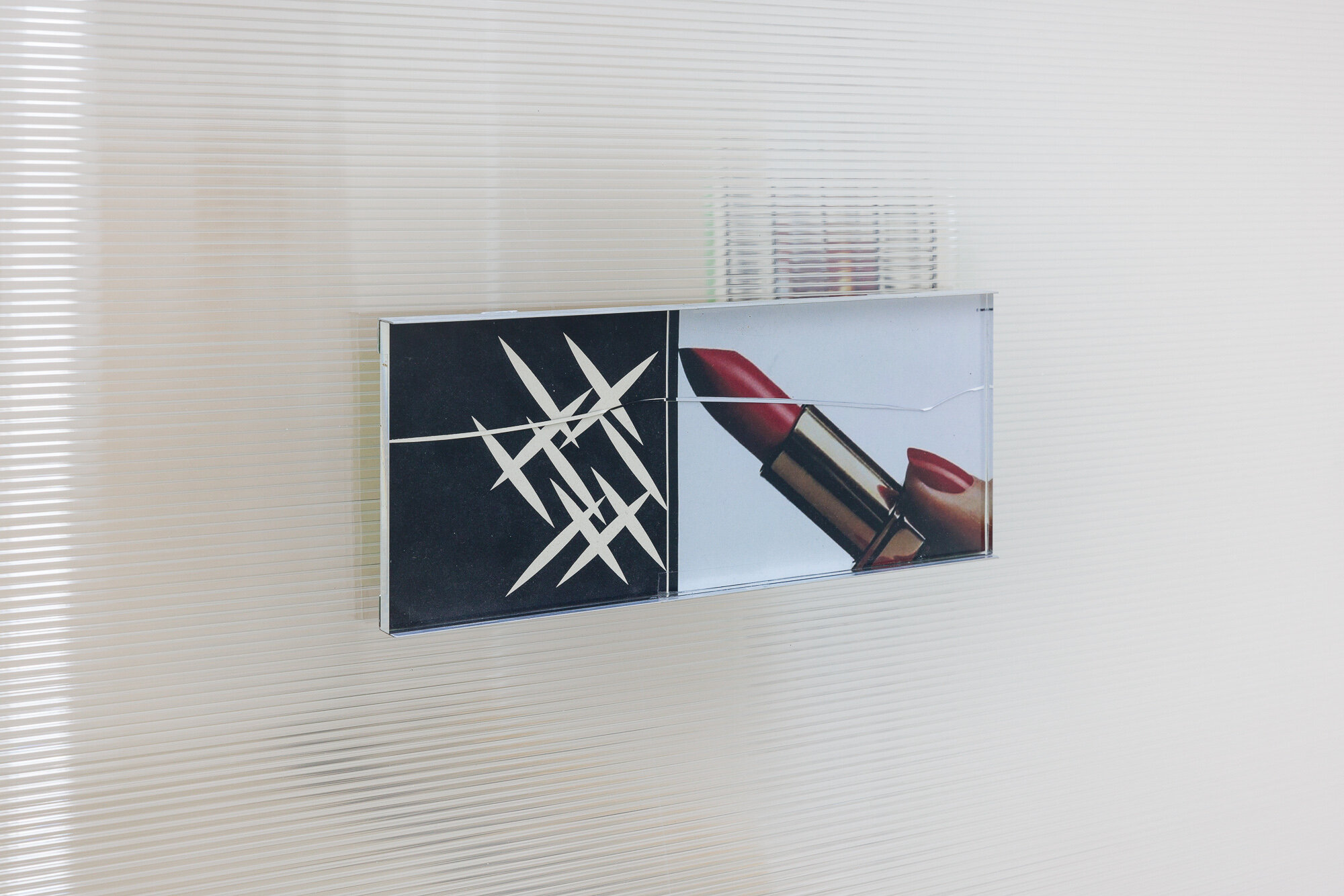Lorenza Longhi

Lorenza Longhi works in painting, as well as with collages, objects, and spatial interventions. Her works involve the reproduction or direct appropriation of specific objects and visual media such as photography and other graphic image material— from items of furniture to elements from advertising and communication strategies. Longhi selects elements that point out power structures or serve as such, isolating these and highlighting them. In a certain sense, this is an objectified performance and replica of certain kinds of economies that stand behind the façade of an object and that shape its appearance.
The two works in this exhibition reflect an interest and an approach that are characteristic of the artist’s work — a certain DIY method of productionand presentation, and also a preference for the combination of different materials and images. Longhi uses series of pictures that come from a bygone and highlypriced world of consumer goods, such as old adverts for luxury brand lipsticks. She deploys these in collages that utilize various methods so as to create contrasts. In one, images are placed within grids from modernist painting, like those in the works of Mondrian. The role models and the binary notions of gender that these designs are based on also appear as similarly historical or old.
These works are presented within two “pavilions,” each of which is the frame for the two installations in the exhibition. In each, Longhi places a groupof collages within a simple structure made of corrugated sheets — standard building materials selected for their simplicity that here form an infrastructure for the pictures. Seen from above, these two works make a “S” shape, with small cabinet-like rooms in each of which a single collage is presented.
This architectural framing leads to a contrast between the value of the luxury brand and that of its display, a contrast that evidences the artist’s resistance to the images she shows and to their original contexts. Her approach is critical, based on presenting and demonstrating their mechanisms and thus depriving them of their effects and power. The artist also uses a transparent form of display that shows the rear of her collages and here also thus makes the material and the ways in which the collages are constructed visible. She also uses cheap materials and leaves traces of the work process she has conducted. In some cases, the rear sides include additional textual elements that function as comments on the works. For example, one collage from Untitled (Particuliere 505 Pavilion) (2021) has the words “what a catastrophe his” on the back, with one more final word probably covered bythe lower frame. Though the two works Untitled (Particuliere 505 Pavilion) and Untitled (P. de Résistance) take a very critical view of the original materials they appropriate, the mode is nonetheless poetic,operating first and foremost by means of a conceptual framing with the contrasting materials that have their own aesthetic and that contribute to undermining and presenting the modernist image worlds.
Untitled (Particuliere 505 Pavillion), 2021
Collages: plexiglass, aluminium, rivets (13 × 33 × 1.5 cmeach), installed on mobile pavilion: magnets plastic panels, magnets, ropes, cable ties, rivets (variable dimension)
Courtesy Oskar Weiss, Zurich
Untitled (P. de Résistance), 2021
Collages: Plexiglas, aluminum, rivets (variable dimension) installed on mobile pavilion: magnets plastic panels, magnets, ropes, cable ties, rivets (variable dimension)
Courtesy the artist; Fanta-MLN, Milan
Lorenza Longhi
Solo (et al.): Fanta, Milan (2022, 2019, 2016), Ordet, Milan (2022), Kunsthalle Zurich (2021), Weiss Falk, Basel (2021), Bungalow, Berlin (2020), La Plage, Paris (2019), Playmouth Rock, Zurich (2019); Shows (et al.): Layr, Vienna (2022), Swiss Art Awards, Messe Basel (2022), PART, Rimini (2022), Bonner Kunstverein (2022), MACRO, Museum of Contemporarty Art of Rome, Rome (2022), Kunstverein Bielefeld (2021), Fondazione Prada, Venice (2021), Stadtgalerie, Bern (2021), Le Commun, Geneva (2021), Deborah Schamoni, Munich (2021), 17.Quadriennale d’arte, Rom, Rome (2020), Grand Palais, Bern (2020), Hyphen, Milan (2019), Kunst Halle St.Gallen (2019)